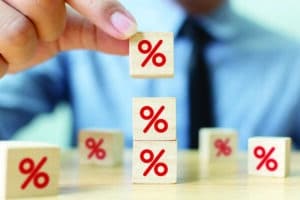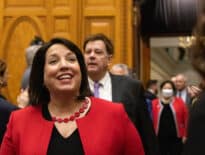With bank stocks cratering Monday as investors in regional banks like First Republic Bank and now-defunct Silicon Valley Bank worry about what lender may be next to topple, some investors are calling for the Fed to make cuts to interest rates soon to stanch the bleeding.
Regulators on Friday closed Silicon Valley Bank as investors withdrew billions of dollars from the bank in a matter of hours, marking the second-largest U.S. bank failure behind the 2008 failure of Washington Mutual. They also announced Sunday that New York-based Signature Bank was being seized after it became the third-largest bank to fail in U.S. history.
The most pressure is on the regional banks a couple steps below in size of the massive, “too-big-to-fail” banks that helped take down the economy in 2007 and 2008. Shares of First Republic plunged 65.4 percent, even after the bank said Sunday it had strengthened its finances with cash from the Federal Reserve and JPMorgan Chase.
Huge banks, which have been repeatedly stress-tested by regulators following the 2008 financial crisis, weren’t down as much. JPMorgan Chase fell 1.3 percent, and Bank of America dropped 3.3 percent.
“So far, it seems that the potential problem banks are few, and importantly do not extend to the so-called systemically important banks,” analysts at ING said.
The broader market flipped from losses to gains as expectations built that all the furor will mean the Fed won’t reaccelerate its rate hikes, as it had been threatening to do. Such a move could give the economy and banking system more breathing space, but it could also give inflation more oxygen.
The wider expectation, though, is that the Fed will likely pause or hold off on accelerating its rate hikes at its next meeting later this month.
“At this point in time, depending on reactions in financial markets and eventual fallout on the overall economy, we wouldn’t rule out that the hiking cycle could even be over and that the next move by Fed officials may be lower not higher,” said Kevin Cummins, chief U.S. economist at NatWest.
That would be a sharp turnaround from expectations earlier last week, when many traders were forecasting the Fed would hike its key overnight interest rate by 0.50 percentage points at its next meeting. That would be after the Fed had just downshifted last month to an increase of 0.25 points from earlier hikes of 0.50 and 0.75 points.
The fear was that stubbornly high inflation would force the Fed to get even tougher, and investors were bracing for the Fed to keep hiking at least a couple more times after that.
Higher interest rates can drag down inflation by slowing the economy, but they raise the risk of a recession later on. They also hit prices for stocks, as well as bonds already sitting in investors’ portfolios.
That latter effect is one of the reasons for Silicon Valley Bank’s troubles. The Fed began hiking interest rates almost exactly a year ago, and its fastest flurry in decades has brought its key overnight rate to a range of 4.50 percent to 4.75 percent. That’s up from virtually zero.
That has hurt the investment portfolios of banks, which often park their cash in Treasurys because they’re considered among the safest investments on Earth.
Rising rates and other moves reverse the Fed’s tremendous support for the economy during the pandemic have been effectively draining cash from the system, something Wall Street calls “liquidity.”
“Restoring liquidity in the banking system is easier than restoring confidence, and today it is clearly about the latter,” said Quincy Krosby, chief global strategist for LPL Financial.
All the fear led the price of gold to climb, as investors looked for things that seemed safe. It rose 2.6 percent to $1,914.80 per ounce.
Prices for Treasurys also shot higher on both demand for something safe and expectations for an easier Fed. That in turn sent their yields lower, and the yield on the 10-year Treasury plunged to 3.47 percent from 3.70 percent late Friday. That’s a major move for the bond market.
The two-year yield, which moves more on expectations for the Fed, had an even more breath-taking drop. It fell to 4.06 percent from 4.59 percent Friday.




 |
| 


